Christian Symbols on Roman coins:
An overview and a comprehensive list of copper coins to AD 364.
The first indications of Christianity on Roman coins occur under emperor Constantine who ruled 307-337 AD. Only a few years before his reign the emperors were still supporting the old gods and severely persecuting Christians, but Constantine advocated for the Christian God and became very involved in church matters. By the end of his reign in 337 it was the religion favored by the state. On coins minted under Constantine there are only some veiled references to Christianity, but soon the frequency of Christian references increased and by 350 Christian references became overt.
Contents: This page
1) first discusses Christian types, then
2) discusses Christian symbols, which occur on coins before Christian types appear. The early symbols are either a cross or a chi-rho ( ), and finally
), and finally
3) gives an illustrated list in chronological order, of possible Christian references on Roman AE (copper) coins prior to AD 364 (Valentinian's reign began in 364, after which most Roman coins displayed Christian symbols.)
A second page with far more details about the three most-famous Christian types which are discussed in less detail next on this page.
Pages with examples of the reverse types in listed in the tables below.
A page of academic references.
What's new? 2025, March 9: A timeline of events with links to the relevant coins.
2023, August 30: A Constantine with a cross-like symbol. 2022, April 3: Three types of Magnentius added to Table 6 (6.7, 6.8, and 6.9).

The first type featuring a Christian symbol, the chi-rho.
An early Christian type on a large (27 mm) copper coin of the
Roman emperor Magnentius (350-353 AD)
with a large chi-rho (chi, X, and rho, P, which are the first letters in, and when crossed like this, an abbreviation for, Christ = CHRistus)
flanked by A, alpha, and ω (the beginning and the end--of the Greek alphabet--another Christian reference).
(This type is discussed in greater detail on this linked page.)

The first Christian type. Unfortunately, the meaning is uncertain.
A small (18 mm) coin of Constantine (emperor, 307-337 AD) with an
enigmatic type of a standard surmounted by a chi-rho ( )
)
and planted in a serpent with head plunging downward,
with legend SPES PVBLIC ("Hope of the public"),
struck in AD 326 in the first issue from the Constantinople mint
(Discussed in greater detail on this linked page).
 The first overtly Christian legend.
The first overtly Christian legend.
A 21 mm coin struck by Vetranio in 350.
A small chi-rho on a standard (a "labarum") held by the emperor who is being crowned by Victory,
with the legend consisting of the famous words reportedly said by God to Constantine in his vision before the decisive battle of the Milvian bridge:
HOC SIGNO VICTOR ERIS (beginning at 7:00)
("With the sign, you will be victorious").
A 21 mm coin struck by Vetranio in 350.
(Discussed in greater detail on this linked page).
An earlier extremely rare coin of Crispus makes it certain that the Christian "sign" was a chi-rho.
 Chi-rho on the shield.
Chi-rho on the shield.
IVL CRISPVS NOB CAES ("IVL" for "Julius")
Bust of laureate Crispus left, holding spear in his right hand pointing back over his right far shoulder and holding a shield in his left hand. The shield has a bold chi-rho on it.
BEATA TRAN - QUILLITAS around votive altar inscribed VO/TIS/XX, with globe on top and *** above.
In exergue: • PTR • , a mintmark of Trier
Struck 322-323 according to RIC. RIC Trier 372
This coin: 19-17 mm.
[Ex Langtoft hoard, found Sunday, 24 Sept. 2000 at Langtoft, near East Riding, Yorkshire, England.]
Crispus was the first son of Constantine and was executed in 326, so even if the RIC date is not precise, this type certainly was issued at the latest in 326 (no more than 14 years after the battle of the Milvian Bridge) when many people would have remembered the event and understood the reference. It shows a bold chi-rho symbol on the shield held by Crispus (as described by Lactantius, on a linked page with more details).
Note for collectors: Coins of Crispus are common and this reverse type is common, but this variety with the chi-rho on the shield is extremely rare and desirable. The Hunter collection catalog, volume 5, illustrates one, in much worse condition than this one, and a recent book has an excellent example on the cover.
A type very similar to that of Magnentius (the first coin on this page) was issued in the name of Constantius II at Trier in the last months of the reign of Magnentius:
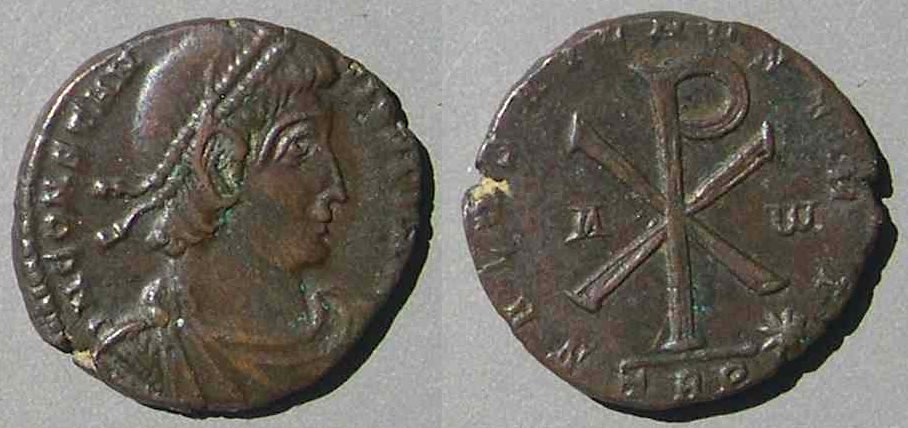 Constantius II. 337-361
Constantius II. 337-361
This coin: 23 mm. 6.86 grams.
DN CONSTAN-TIVS PF AVG
Laureate bust of Constantius II right
/large chi-rho with small alpha (A) and omega (ω) on either side.
SALVS AVG NOSTRI (instead of SALVS DD NN AVG ET CAES)
TRP * (a mintmark of Trier)
RIC Trier 335. Struck 352 or 353, in the last months of the reign of Magnetius and Decentius.
This type is attributed to the "Revolt of Poemenius" at Trier (as described by Ammianus in Lives of the Later Caesars) during the caesarship of Decentius, brother of Magnentius. Magnentius had been a usurper in Gaul while Constantius II was in the east. As Constantius fought his way west, apparently Poemenius declared the support of Trier for Constantius even before Constantius arrived on the scene. He continued the chi-rho type but naturally changed the legend from the one suitable for two rulers (Magnentius and Decentius) to this similar legend appropriate for a single ruler (Constantius II). Whether or not the city was temporarily retaken by Decentius before Constantius arrived is uncertain. This type is issued only at Trier.
Note for collectors: This type is scarce and in significant demand. The flan is regularly too small for the dies, so it is usually crowded (as this one is missing the right side of the obverse legend and the outer edges of some reverse letters). Nevertheless, at any given time there will probably be some on the market.
Christian Symbols: There are only four Christian symbols on Roman coins of the fourth century: the chi-rho, cross (square or long), cross-rho, and the hand of God (without and with wreath). The chi-rho ( , a.k.a. christogram) is formed from the first two letters of "Christ" in Greek (chi = X and rho = P). The chi-rho is used far more commonly than the cross or cross-rho, but on one issue they are interchangeable. In AD 348 there was a coin reform in which a new, larger, denomination was introduced with the legend FEL TEMP REPARATIO ("Happy times are here again") and several types, one of which is described as "emperor standing left with standard and two captives." The "standard" has vexillum (a flag) mounted on the standard and adorned in three ways:
, a.k.a. christogram) is formed from the first two letters of "Christ" in Greek (chi = X and rho = P). The chi-rho is used far more commonly than the cross or cross-rho, but on one issue they are interchangeable. In AD 348 there was a coin reform in which a new, larger, denomination was introduced with the legend FEL TEMP REPARATIO ("Happy times are here again") and several types, one of which is described as "emperor standing left with standard and two captives." The "standard" has vexillum (a flag) mounted on the standard and adorned in three ways:
a cross:  , a chi-rho:
, a chi-rho:  , or a cross-rho:
, or a cross-rho:  (illustrated below on coins from Antioch, Nicomedia, and Antioch, respectively)
(illustrated below on coins from Antioch, Nicomedia, and Antioch, respectively)


Three coins of Constantius II (Caesar 324-337 and Augustus 337-361) struck c. 348-350. Each is 21 or 20 mm.
Bust of Constantius II left, DN CONSTANTIVS PF AVG
pearl-diademed and holding small globe in his right hand.
The reverse (top row) has a mint mark identifying the mint city (Antioch, Nicomedia, and Antioch, respectitvely).
Note for collectors: This "two-captives" type is very common, easily available, and inexpensive. The chi-rho is the most common of the three symbols, but all are available. Make sure the tiny symbol is clear--sometimes most of the coin is nice but the symbol is not legible.
The "hand of God": The "hand of God" is on fewer types, but the coins are common. It first appears after the death of Constantine in 337 on a "deification" issue struck by his sons.
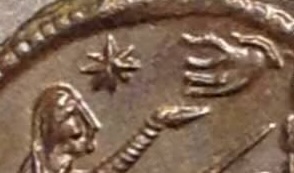
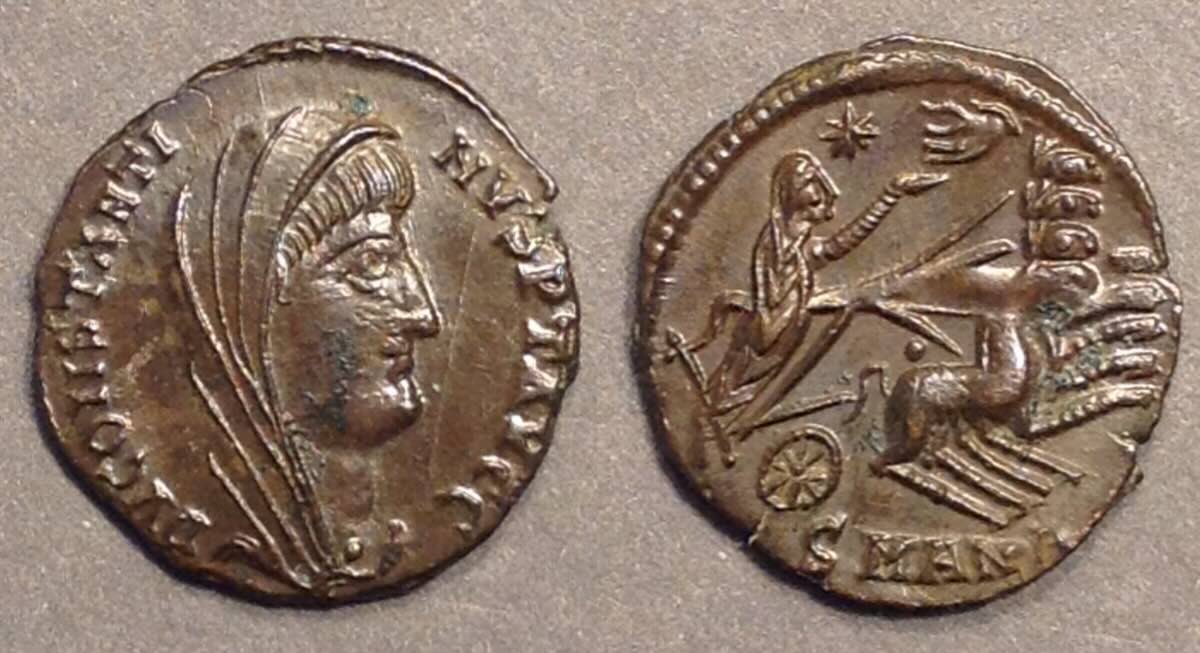 Constantine the Great
Constantine the Great
Struck 337-340 just after Constantine's death in 337.
15 mm. 1.76 grams
DV CONSTANTI-NVS PT AVGG
Veiled head of Constantine right
Emperor in biga right being received by the hand of God reaching down from the sky.
The use of a chariot (instead of huge eagle carrying the emperor) with hand of God is new.
SMALΓ (a mintmark of Alexandria, Egypt).
It is not explicit on the coin that this issue is Christian-related. However, we know it is from the ancient Christian author Eusebius, who wrote, "
At the same time coins were struck portraying the Blessed One on the obverse in the form of one with head veiled, on the reverse like a charioteer on a quadriga, being taken up by a right hand stretched out to him from above," Life of Constantine IV, 73.
"DV" in the obverse legend abbreviates "Divus" and "PT AVGG" abbreviates "Pater Augusti" which translates to "father of the augusti." In previous centuries under the pagan religions some emperors had been "deified" (more or less enrolled among the gods) after their deaths and shown on coins riding an eagle up into the sky. Although the concept was not really Christian, it is alluded to on this common issue of Constantine.
A note for collectors: This small type is common, but often worn, ill-struck, or off-center enough to obscure the hand of God. Generally the type is very inexpensive, but a well-struck full-flan piece with a bold hand of God will cost significantly more.
Much later, after Christianity was well-established, a type of Arcadius has a clear hand of God holding a wreath crowning the emperor:
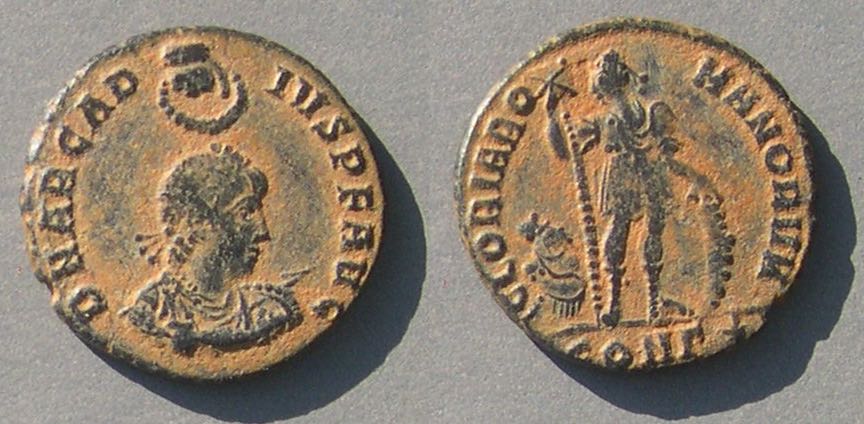 Arcadius, 383-408
Arcadius, 383-408
Struck 383 as his first issue
20 mm. 4.52 grams
DN ARCAD-IVS PF AVG, bust right holding spear forward and left holding shield
Hand of God above crowning him with a wreath
GLORIA RO-MANORVM
Emperor standing front, facing left, holding standard and resting left of shield, at feet left a captive
mintmark: CONΓ *
RIC Constantinople 53a
Only the eastern emperor Arcadius and his wife Eudoxia have coins with a hand of God like this, and only in the time period 383-388. Additional examples can be found in Table 7.
Note for collectors: The "hand of God" obverse is very unusual on Roman coins, but this type is nevertheless readily available and apparently not much sought after. Inexpensive examples can be found. Many are "VF" but it is very difficult to find one in true EF. Similar appearances of the hand of God are on coins of Eudoxia (wife of Arcadius) struck c. 400.
The emperor with "Eyes to Heaven" does not employ a separate symbol, but the type was interpreted by ancients as Christian.
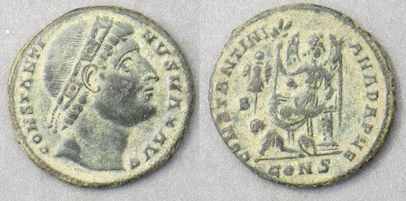 Constantine, 307-337. Struck 328.
Constantine, 307-337. Struck 328.
Obverse portrait with head tilted back to raise his "eyes to heaven."
This obverse appears with three distinct reverses.
Type 1.15
This coin: 19 mm. 3.16 grams. 6:00.
Reverse: CONSTANTINIANA DAFNE
Victory seated left, captive to left below, trophy in field
Mintmark: CONS, B in left field
RIC Constantinople 32
The ancient author Eusebius (IV.15) wrote, "How deeply his soul was impressed by the power of divine faith may be understood from the circumstance that he directed his likeness to be stamped on the golden coin of the empire with eyes uplifted as in the posture of prayer to God: and this money became current throughout the Roman world."
The list of types with symbols that are possibly Christian
Collectors like to list all the coin types pertaining to a theme and collect every type. Only reverses are illustrated on this page, but these coins are fully illustrated and there are additional illustrations of similar coins and more discussion of the types on pages linked to the tables and to the images. Click on the image to see both sides of the coin and commentary. Other coins with these symbols, but not in these early series, are discussed in Table 0 (with references that are not Christian) and Table 7 (with Christian references after they became common.) [Not all mints and RIC numbers are given. Some missing ones will be filled in over time.]
Table 1: to 337: Before the death of Constantine in 337
Table 2: 337-340: After the death of Constantine and before the death of Constantine II
Table 3: 340-348: After the death of Constantine II in 340 and before the coinage reform on 348 that introduced the FEL TEMP REPARATIO types
Table 4: 348-364: Coins of the FEL TEMP REPARATIO coinage reform of 348.
Table 5: 350: Coins issued by Vetranio and Constantius II in opposition to the reign of Magnentius and Decentius
Table 6: 350-353: Coins issued by Magnentius and Decentius.
Other, later, coins on a linked page, Table 7. Table 0, earlier coins that are not Christian related, but which are sometimes mentioned in this context.
Table 1: Period of Constantine, to his death in to 337.
| # |
symbol
size |
rulers |
image (Click on the image to
see the both sides, more examples, and discussion) |
type |
mints |
RIC
# |
RIC
date |
|
1.1
|
cross
|
Constantine
Licinius |
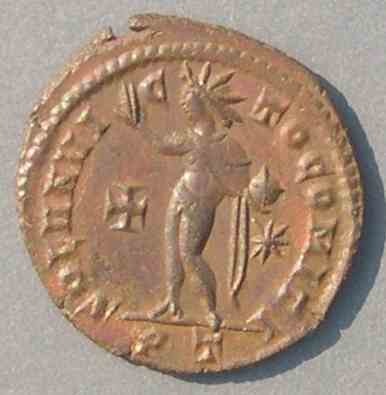 |
SOLI INVICTO COMITI
Sol standing left naked but for chalmys, right hand raised and left holding globe
cross in left field, star in field right |
Ticinum
only |
43-45
46 for
Licinius (r4) |
316 |
| 1.2 |
cross |
Constantine |
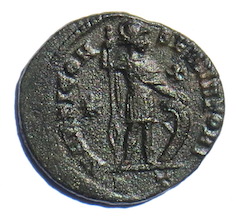 |
MARTI CONSERVATORI
Mars standing right, holding reversed spear and resting left on shield
* in field left, cross in right field
|
Ticinum
only |
47 |
316 |
| 1.3 |
cross |
Constantine |
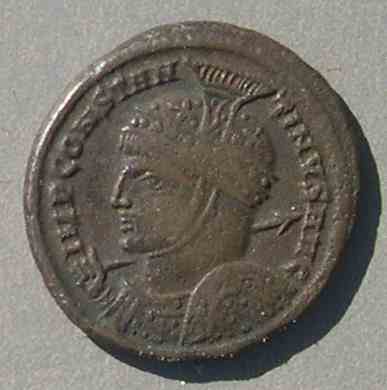 |
VICTORIAE LAETAE PRINC PERP
Two victories facing each other, holding shield inscribed VOT PR on column between them
Obverse: close-fitting helmet with crest and cross in front and back divisions (The cross is not neatly done [unlike 1.1]. It is not convincingly Christian) |
Siscia
(this coin)
xx |
82
(this coin) |
319 |
| 1.4 |
chi-rho |
Constantine |
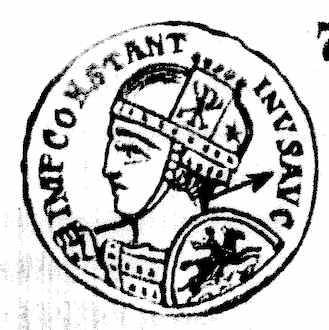 |
VICTORIAE LAETAE PRINC PERP
Two victories facing each other, holding shield inscribed VOT PR on column between them
Obverse: close-fitting helmet with chi-rho in central division
[This is almost the same type as Type 1.3 above, only with a different helmet decoration.] |
Siscia |
61
(officina B only) |
|
| 1.5 |
cross |
Constantine |
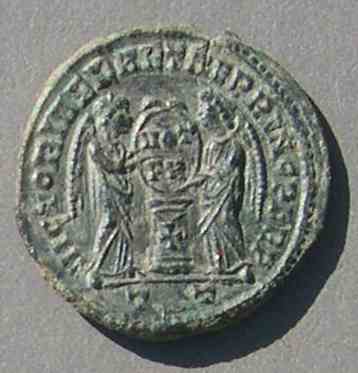 |
VICTORIAE LAETAE PRINC PERP
Two victories facing each other, holding shield inscribed VOT PR on column between them
cross on the column
|
Ticinum
London
Lyons
xx |
86
168
75
|
318-9 |
| 1.6 |
I X
monogram
(chi-rho) |
Constantine
Crispus
Constantine II |
 |
VIRTVS EXERCIT
VOT XX on standard between two seated captives facing outward
I X monogram (or a six-pointed star) in field left
(often called a chi-rho by dealers to boost the desirability of the type. There is sometimes a bump at the top (as in the illustration), which may be just a terminal dot to guide the engraving of the I, or may be a subtle indication of the turned bump of a rho.) |
several mints
including
Ticinum,
Aquileia, and
Thessalonica |
82 |
|
| 1.7 |
chi-rho |
Constantine |
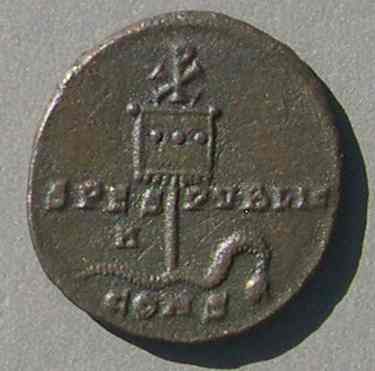 |
SPES PVBLIC across field, A in left field,
standard planted in snake/serpent with head curved down, three dots on vexillum, chi-rho above
CONS below
This and the following coins certainly reference Christianity. |
Constantinople
only |
19
only
(r4) |
327 |
| 1.8 |
chi-rho |
Crispus |
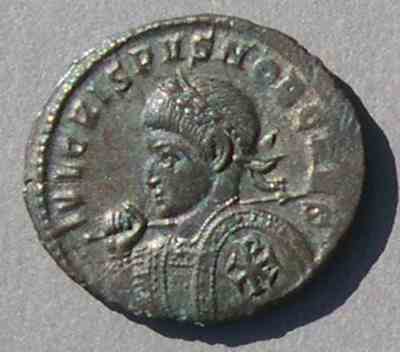 |
BEATA TRANQVILLITAS, globe on altar inscribed VO/TIS/XX, three stars above
Bust of Crispus left holding spear over shoulder and shield, with bold chi-rho on the shield
[This remarkable shield is known only for Crispus, not for Constantine]
|
Trier
only |
372
(which includes
many
varieties
without
the ci-rho) |
322-3 |
| 1.9 |
chi-rho |
VRBS
ROMA |
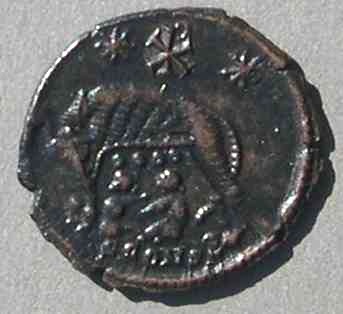 |
Obverse: VRBS ROMA, Roma helmeted and wearing imperial mantle left
No legend: wolf and twins, two stars above with chi-rho between |
Constantina
= Arles
only |
385,
400 |
334-6 |
| 1.10 |
chi-rho |
CONSTAN-TINOPOLIS |
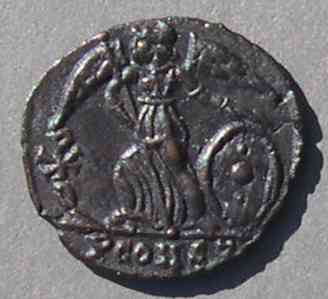 |
Obverse: CONSTANTINOPOLIS, Constantinopolis helmeted left
No legend: Victory advancing left, wings spread,
with scepter and left on shield on ground behind,
right foot on prow,
chi-rho in field left |
Constantina
= Arles
only |
386,
401 |
334-6 |
| 1.11 |
chi-rho |
Constantine
Constantine II
Constantius II
Constans |
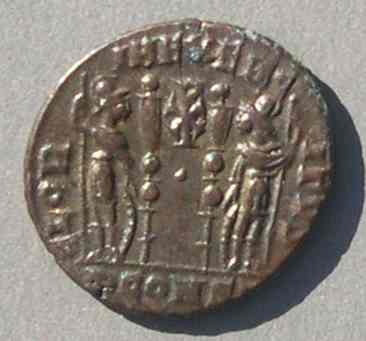 |
GLORIA EXERCITVS, two soldiers and two standards,
chi-rho high between standards |
Constantina
= Arles
only |
381
382
383
384
(all r4 or
rarer) |
334 |
| 1.12 |
cross
long |
Constantine
Constantine II
Constantius II
Constans |
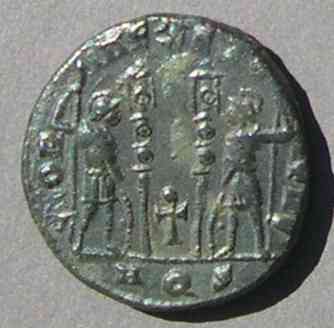 |
GLORIA EXERCITVS, two soldiers and two standards,
long cross low between standards |
Aquileia
only |
124
125
126
127
(all r3 or
rarer) |
334-
Sept
335 |
| 1.13 |
chi-rho |
Constantine
Constantine II
Constantius II
Constans
Delmatius |
 |
GLORIA EXERCITVS, two soldiers and
one standard with chi-rho
[This is similar to the first type (2.1) in the next table which was issued in a distinct time period and at a different mint. For proof that this one is earlier and the other later, see the discussion.] |
Constantina
= Arles
and Lyon |
394
395
396
397
398-9
(all r3 or
rarer) |
336 |
| 1.14 |
cross of
St. Andrew(?) |
Constantine
Constantine II
Constantius II
Constans
Delmatius |
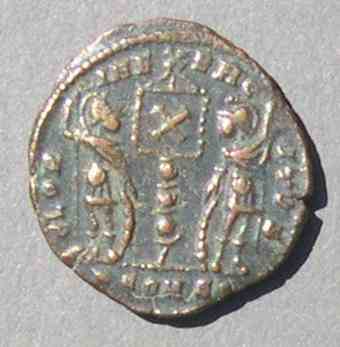 |
GLORIA EXERCITVS, two soldiers and
one standard with cross of St. Andrew: X
(This could be a Greek chi instead, or both.)
|
Constantina
= Arles
only |
402
403
404
405
406
(all r4 or
rarer) |
336-7 |
| 1.15 |
Eyes to Heaven
(no actual symbol) |
Constantine |
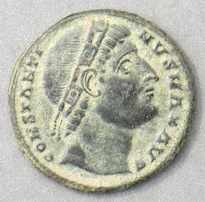 |
CONSTANTI-NVS MAX AVG
diademend head right tilted back raising "eyes to heaven"
with reverses:
1) CONSTANTINIA DAFNE (at Constantinople only)
2) VOT / XXX (Heraclea only)
3) PROVIDENTIAE AVGG (Cyzicus only) |
|
|
|
Table 2: AD 337-340, that is, after the death of Constantine and before the death of Constantine II.
| # |
symbol
size |
rulers |
image |
type |
mint |
RIC
# |
RIC
date |
| 2.1 |
chi-rho |
Constantine II
Constans
Constantius II |
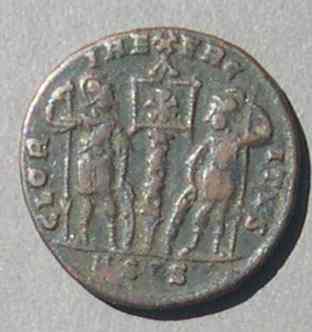 |
AE4: GLORIA EXERCITVS, two soldiers and one standard with chi-rho
ASIS (commonly) or PLG (rarely) in exergue
[The Siscia mint did not mint this type for Constantine I. Unfortunately, Constantine II as Augustus
used the same obverse legend as Constantine I, and sometimes almost the same portrait,
so Siscia mintmarked chi-rho coins are often incorrectly attributed to Constantine the Great.
See the discussion for the proof.]
[This is similar to Type 1.12, but issued in a distinct time period and at different mints.] |
Siscia
Lugdunum
(Lyons)
Aquileia |
100
91
8 (Cs2) |
337-340 |
| 2.2 |
cross |
Constantius II
Constans |
 |
AE4: GLORIA EXERCITVS, two soldiers and one standard with cross
TRP in exergue |
Trier
|
39-40
41
|
337-340 |
| 2.3 |
cross |
Theodora |
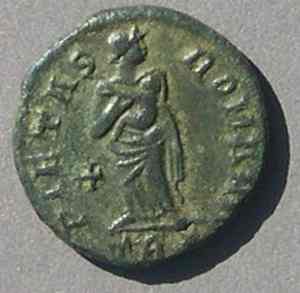 |
AE4: PIETAS ROMANA, Pietas standing left holding child in arms
cross in left field
[Most coins of this type do not have a cross.] |
Trier |
43 |
337-340
Callu says
335 |
| 2.4 |
cross |
Helena |
 |
AE4: PAX PVBLICA, Pax standing left holding branch and transverse scepter
cross in field left
[Most coins of this type do not have a cross.] |
Trier |
42 |
337-340 |
| 2.5 |
Hand
of God |
Divus
Constantine |
 |
AE4: Constantine in quadriga galloping right, star near forehead,
arm and hand extended outward toward Hand of God above.
(Discussed above) |
many |
|
337-340 |
Table 3: AD 340-348, after the death of Constantine II in 340 and before the coinage reform on 348 that introduced the FEL TEMP REPARATIO types
| # |
symbol
size |
rulers |
image |
type |
mint |
RIC
# |
RIC
date |
| 3.1 |
chi-rho |
Constans
Constantius II |
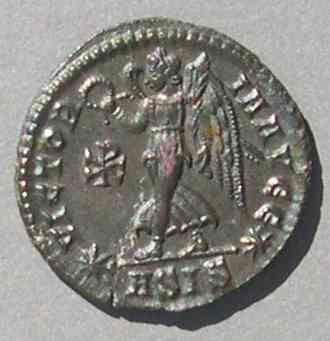 |
VICTORIA AVGG, Victory advancing left, head left, holding wreath and palm
chi-rho in field left |
Siscia |
177
176 |
340-8
maybe
just 347 |
| 3.2 |
chi-rho |
Constans
Constantius II |
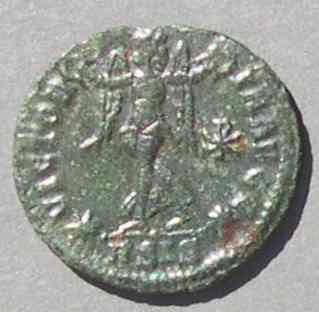 |
VICTORIA AVGG, Victory walking left, head right, holding wreath in each hand
chi-rho in field right |
Siscia |
181
180 |
347 |
Table 4: AD 348-364, coins of the "FEL TEMP REPARATIO" coinage reform of 348 and before the reign of Valentianian (excluding those related to the reign of Magnentius which are in the next table).
| # |
symbol
size |
rulers |
image |
type |
mint |
RIC
# |
RIC
date |
| 4.1 |
chi-rho
or
cross-rho
or cross |
Constantius II
Constans |
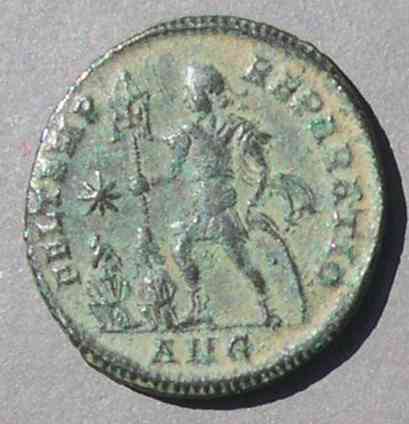 |
AE2: FEL TEMP REPARATIO
"emperor and two captives"
[This example has a cross. The linked page has others with a chi-rho or cross-rho.] |
many |
|
|
| 4.2 |
chi-rho |
Constans
Constantius II |
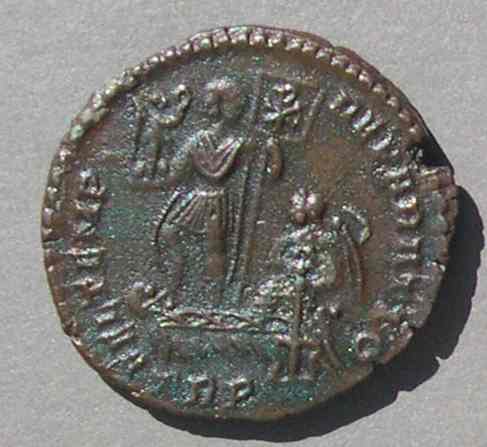 |
AE2: FEL TEMP REPARATIO ("Happy times are here again")
"galley"
emperor standing on bow of galley left, holding in right hand Victory on globe crowning him and in left hand a standard with chi-rho. Victory steers the galley with a rudder. (This is symbolically the "ship of state.") |
many |
|
|
| 4.3 |
chi-rho |
Constans
Constantius II |
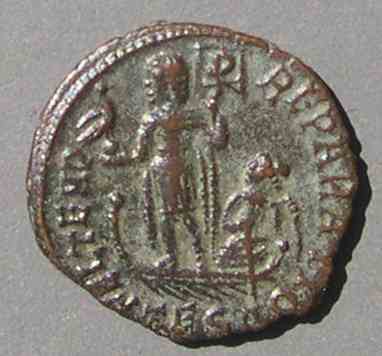 |
AE3: FEL TEMP REPARATIO
"galley"
[This is the same type as above, but of distinctly smaller size. It seems to have been issued simultaneously as a half-denomination. The size is issued by both Constantius II and Constans (whose reign ended in 350), showing it cannot be a later, reduced version of the denomination of 4.2. However, later the type was imitated in Britain in this size and sizes even smaller than this.] |
Thessalonica |
|
|
| 4.4 |
|
Constantius II
Constantius Gallus |
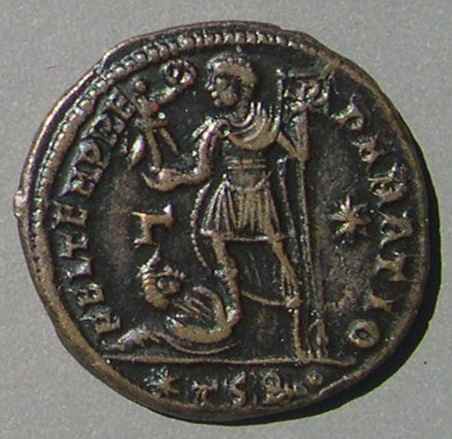 |
AE2: FEL TEMP REPARATO
Emperor standing left holding Victory and standard with chi-rho
one captive at his feet |
Thessalonica
only |
178 |
early in the period
25 Dec. 350 - Winter 354 |
| 4.5 |
chi-rho |
Constantius II
Constantius Gallus |
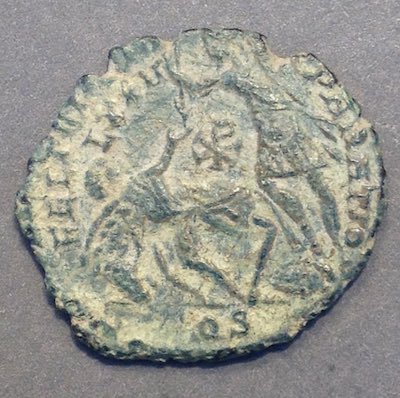 |
AE2: FEL TEMP REPARATO
"Soldier spearing fallen horseman"
LXXII in field (for 72 to the pound)
and mintmark AQS (P, S or T)
chi-rho in the middle
|
Aquileia
only |
195-
196 |
Sept.
352
- Winter
354 |
Table 5: AD 350, coins issued by Vetranio and Constantius II, and later Gallus (in opposition to the reign of the usurpers Magnentius and Decentius, AD 350-353)
| # |
symbol
size |
rulers |
image |
type |
mint |
RIC
# |
RIC
date |
| 5.1 |
chi-rho |
Vetranio
Constantius II
Gallus |
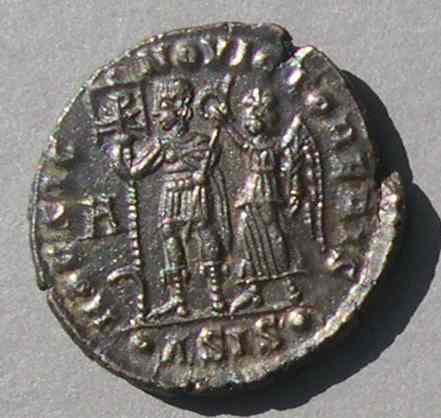 |
Legend: DN VETRA-NIO PF AVG, A in field left, star in field right
Reverse: HOC SIG-NO VICTOR ERIS
Victory crowning emperor holding standard with chi-rho, A in field left.
(Discussed above) |
Siscia for
Vetranio and
Constantius II.
Sirmium for
Constantius II
and Gallus. |
Siscia
275
-292
Sirmium
Cs20
G31 |
19 Jan
-25 Dec
350
Sept
351-
Winter
354 |
| 5.2 |
|
Vetranio
Constantius II
Gallus |
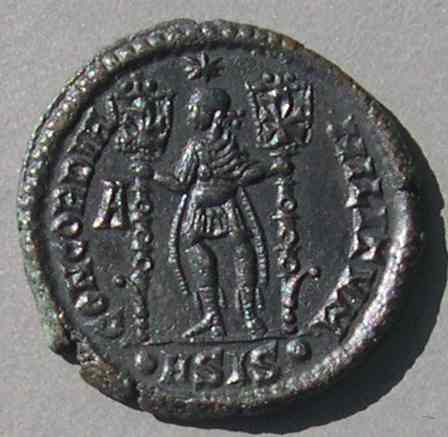 |
CONCORDIA - MILITVM
Emperor standing front, holding in each hand a standard with ch-rho. |
Siscia
Thessalonica
Sirmium |
|
|
| 5.3 |
chi-rho |
Vetranio |
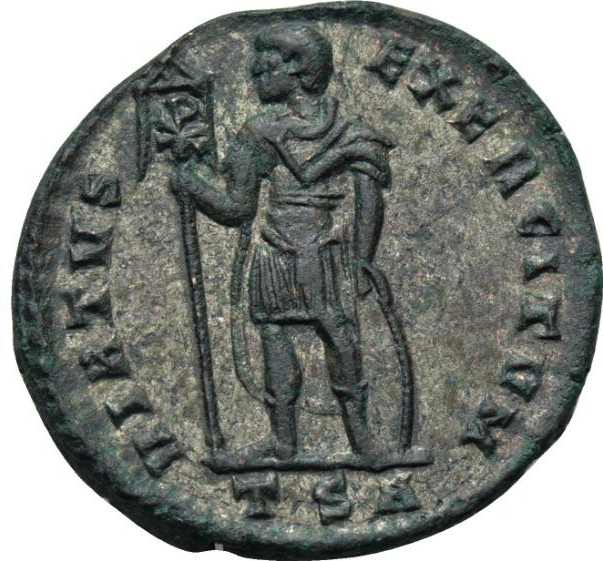 |
VIRTVS - EXERCITVM
Emperor standing front, holding standard with chi-rho, resting left on shield
|
Thessalonica |
126
-127 |
19 Jan
-25 Dec
350 |
| 5.4 |
ci-rho |
Vetranio
Constantius II
Gallus |
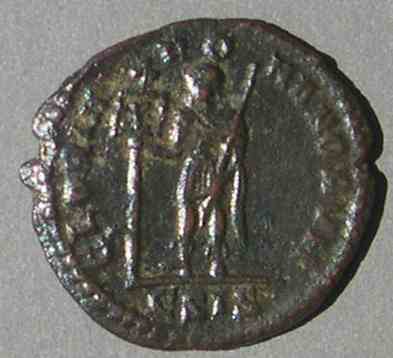 |
AE3: GLORIA ROMANORVM
Emperor standing front, holding standard with chi-rho and reversed spear,
leaning left on shield. |
Siscia |
|
|
| 5.5 |
chi-rho |
Vetranio
|
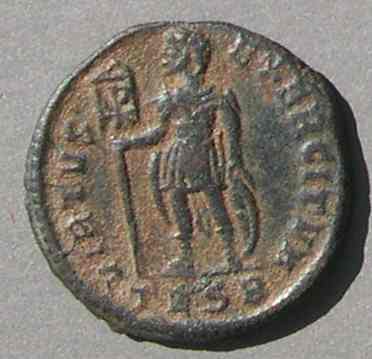 |
AE3: VIRTVS - EXERCITVM
Emperor standing front, holding standard with chi-rho, resting left on shield
[This type is the same as the AE2 above, but in a smaller denomination.]
|
Thessalonica |
Thess
138 |
19 Jan
-25 Dec
350 |
| 5.6 |
chi-rho
alpha and
omega
23 mm |
Constantius II
"revolt of
Pomenius"
at Trier
|
 |
Laureate bust of Constantius II right
/large chi-rho with small alpha (A) and omega (ω) on either side.
SALVS AVG NOSTRI (instead of SALVS DD NN AVG ET CAES)
This is almost the same type as the large "double maiorina" below (6.5), but
adapted from the plural for two emperors (Magnentius and Decentius) to the singular
for the sole emperor, Constantius II, as discussed above. |
Trier
only |
Trier
335 |
struck
352
or 353
in the
last months
of the
reign of
Magnenius |
Table 6: AD 350-353. Coins issued by Magnentius and Decentius.
| # |
symbols
size |
rulers |
image |
type |
mint |
RIC # |
RIC
date |
| 6.1 |
chi-rho
23 mm |
Magnentius |
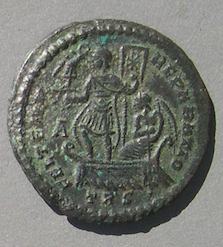 |
FEL TEMP REPARATIO
"galley"
Emperor in military dress standing left on galley
holding Victory on globe and standard with chi-rho
Victory wth rudder at stern
A in field left
This is the only mint and variety [TRP or TRS] |
Trier |
Trier
260 |
19 Jan.
350-
Spring
351 |
| 6.2 |
chi-rho
22 mm |
Magnentius |
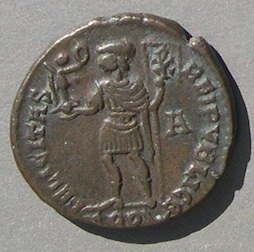 |
FELICITAS REIPVBLICE
emperor standing left holding Victory on globe
and labarum with chi-rho |
|
|
Jan. 350-
Spring 351 |
| 6.3 |
chi-rho
or
cross rho
22-20
mm |
Magnentius
Decentius
Variety B:
Constantius II
Gallus
|
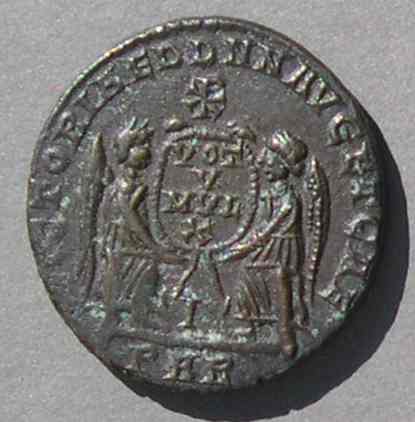
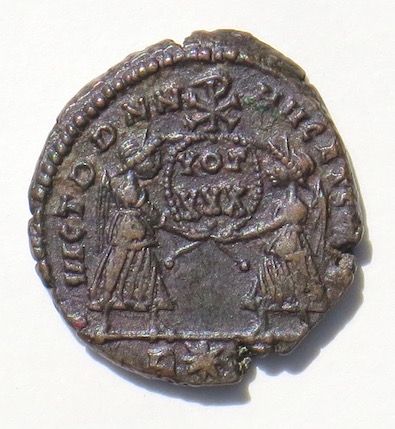
|
VICTORIAE DD NN AVG ET CAE(S)
Two victories holding shield/wreath between them inscribed VOT V MVL X
with chi-rho above
[some have a cross-rho instead]
The Christian symbol is not part of the type;
the type is more commonly seen without one.
Variety B: VICT DD NN AVG ET CAES
instead of VICTORIAE DD NN AVG ET CAE(S)
VOT/XXX instead of VOT/V/MVLT/X
|
only
Rome
|
251-253
|
|
| 6.4 |
23-24
mm |
|
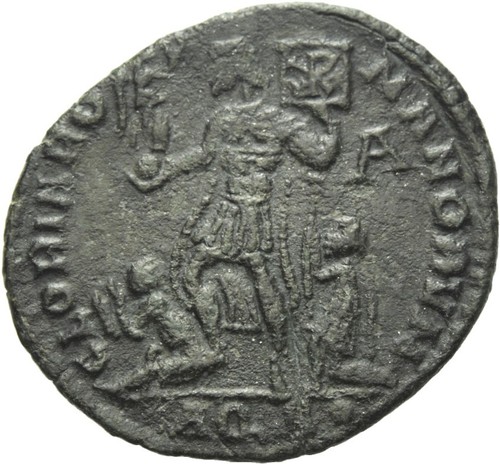 |
GLORIA ROMANORVM
Emperor holding Victory on globe crowning him
holding labarum with chi-rho in left
captives to his left and right
A in field right |
|
Aquileia
149 |
Jan. 350-
Sept. 352 |
| 6.5 |
chi-rho
27 mm |
|
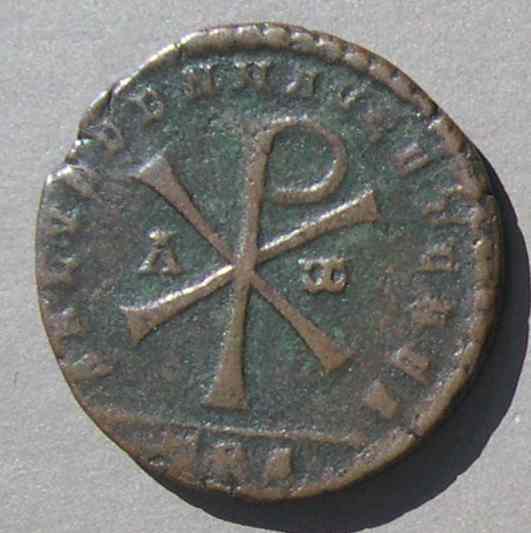 |
SALVS DD NN AVG ET CAES
large chi-rho with alpha and omega on either side.
(Discussed above) |
|
Trier |
|
| 6.6 |
chi-rho
17 mm |
|
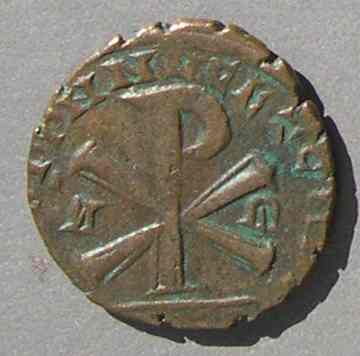 |
SALVS DD NN AVG ET CAES
large chi-rho with alpha and omega on either side.
This is the same type as the large "double maiorina" as above,
but in a smaller denomination, the "maiorina." |
xx |
|
|
| 6.7 |
chi-rho
17 mm |
Magnentius |
 |
FEL TEMP REPARATIO
Emperor holding standard (labarum) with chi-rho.
(RIC says cross-rho but their photo, less clear than this one, seems to also show a chi-rho.) |
only
Lyons
|
Lyons
108 "R"
but I think
very rare |
Jan. 350
- Spring 351
(i.e. before Decentius)
|
| 6.8 |
chi-rho
25 mm |
Magnentius
Decentius |
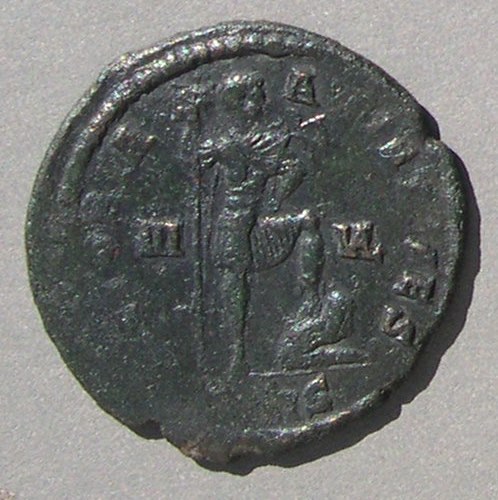 |
VICTORIA AVG ET CAES
Emperor standing right with toot on captive, holding standard (labarum) with chi-rho.
[The chi rho is barely visible on this example]
|
Siscia
|
Siscia
318-319
"R"
|
Sept. 351
|
| 6.9 |
chi-rho
22 mm |
Magnentius
only
|
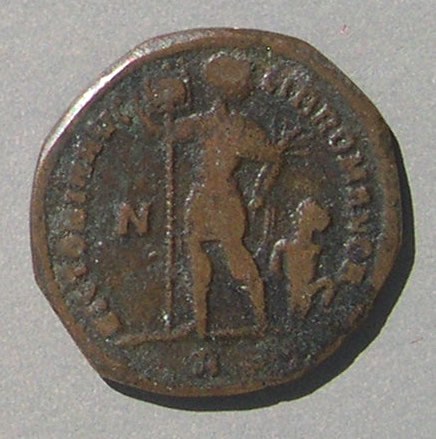 |
VICTORIA AVG LIB ROMANOR
Emperor holding standard (labarum) with chi-rho, holding olive branch in left, to right a kneeling and bound captive.
(This is the smaller version with this legend. The larger version has an eagle on the banner.)
[The chi rho is barely visible on this example]
|
Rome
|
Rome 193 "R" |
"Before
3 June 350"
|
Continue with more images, more coins, and more discussion of types from Table 1.
The main types at the top of this page are discussed in greater depth here.
Academic references are listed on a page here.
Go to a page with a few later coins with Christian references.
Go to page with a few earlier "chi-rho" coins that are not Christian references.
Go to a timeline of relevant events.
Return to the top.
Go to the master list of site contents, which includes many pages on many other topics besides Christian symbolism.




 Constantius II. 337-361
Constantius II. 337-361 , a chi-rho:
, a chi-rho:  , or a cross-rho:
, or a cross-rho:  (illustrated below on coins from Antioch, Nicomedia, and Antioch, respectively)
(illustrated below on coins from Antioch, Nicomedia, and Antioch, respectively)


 Constantine the Great
Constantine the Great 
 Constantine, 307-337. Struck 328.
Constantine, 307-337. Struck 328.







































